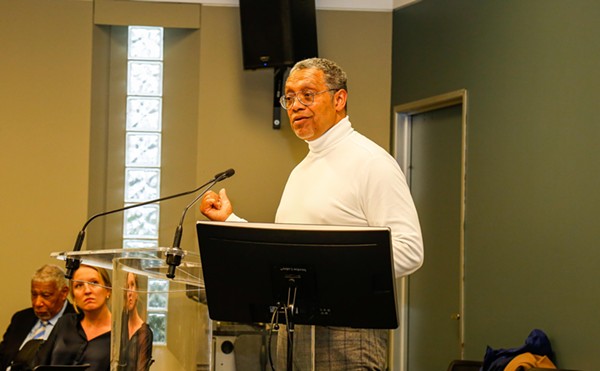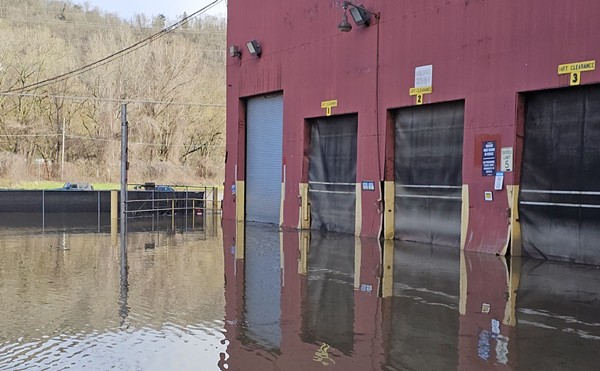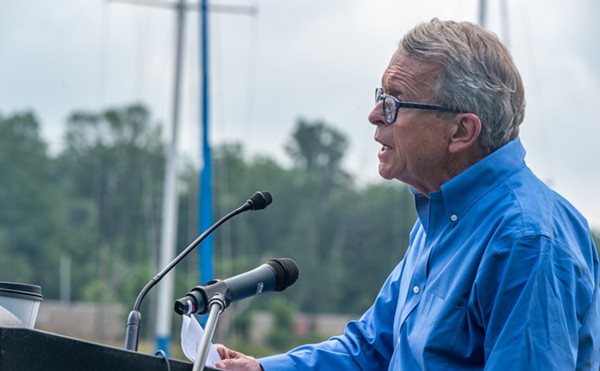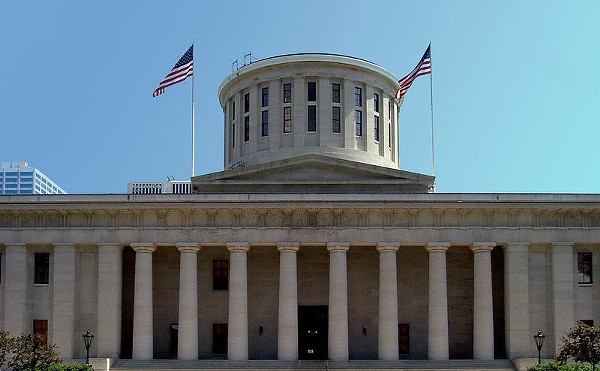Greetings, earthlings.
We are breaking our longstanding silence and utilizing this unorthodox means of communication to acknowledge a special event: The 60th anniversary of the Cleveland Ufology Project, a group devoted to solving the mysteries of flying saucers. Nonbelievers may find this unremarkable. But CUP is now the oldest organization of its kind in the country, and perhaps the world.
Over the decades, CUP has ridden the rapids of the UFO phenomenon: the national obsession sparked by the famous sightings of the late 1940s and early '50s; the Cold War fears that gave rise to Project Blue Book and the seminal contributions of Ohio State astrophysicist J. Allen Hynek; the fever of the 1960s, when a talk by Frank Edwards, the author of Flying Saucers – Serious Business drew 2,000 people to Lakewood Civic Auditorium; the crash of interest and credibility after the 1969 release of the Condon Report; and the bare ebb of survival during the '80s and '90s. Even today, amid trash like "Ancient Aliens" and "UFO Hunters," the organization has maintained impressive standards.
We have watched all this with curiosity and amusement — and to be perfectly honest, some measure of satisfaction. It's flattering when a man like Earl Neff, the longtime chairman of CUP and most significant figure in the organization's history, devotes 40 years of his life to studying our fleeting appearances. Without Neff's tireless efforts to investigate and promote UFOs, there would likely be no CUP today.
Unfortunately, Neff's files have been broken up and scattered around the world; many now fill the shelves at the Archives for UFO Research in Norrkoping, Sweden. This fragmented documentation doesn't add much credibility to an organization whose members can't even tell you exactly when and where the first meeting took place. Still, it's entirely in keeping with a subject which, by its very nature, exists on the edges of belief. The mystery of UFOs is what keeps people intrigued and engaged — and accounts for the perseverance of a group that occupies a unique niche not just locally, but internationally.
"I've spoken to many grass-roots UFO groups, not just in the United States but in England, France, Japan, and Canada," says veteran UFO researcher and writer Peter Robbins. "And I can tell you that the longevity of CUP is absolutely unheard of. Maybe it's something in the air in Ohio. But there is nothing like it in the world."
It would have been easy to mistake CUP's anniversary dinner, held appropriately at the 100th Bomb Group restaurant near the airport last month, for a retiree reunion. Old women hobbled around on canes; men in their 50s, 60s and older bemoaned the effects of the Internet on membership. Even Peter Robbins, the featured guest speaker for the evening, was reprising the first speech he delivered to the organization more than 30 years ago.
Nor would the program have signaled anything unusual. Current co-directors Aaron Clark and Tom Wertman greeted the group of about 45 devotees, who watched a slide show of past meetings and members during dinner, then a short video of sci-fi clips about aliens and space travel from the past 60 years, starting with the famous opening line of the Superman television series: "Look! Up in the sky!"
That was the early 1950s, when everybody was looking up in the sky. The modern era of flying saucers was launched in June 1947, when Kenneth Arnold, a private pilot flying near Mt. Rainier in Washington, reported seeing a string of bright, convex- and crescent-shaped objects go whizzing by the mountain at supersonic speed. Two weeks later, his sighting took on ominous significance when officials at the Roswell Army Air Field base in New Mexico announced they had recovered the remains of a "flying disc" that had crash-landed in the desert.
The Roswell incident began when a rancher named Mac Brazel found some debris on his property that appeared to have fallen from the sky. Many years later, it was revealed to be the remains of an aerial surveillance balloon that was monitoring the upper atmosphere for signs of Soviet atomic weapons tests. But with Cold War paranoia building, Army officials did not want to let the Russians know they were being watched. So they put out a cover story about recovering the wreckage of a UFO, thinking it would provide an effective distraction.
That it did: "RAAF Captures Flying Saucer" the Roswell Daily Record blared in a banner headline on July 8, and the world has never been the same. An entire cottage industry grew up around "the Roswell incident," as it came to be known, with Ohio taking on an important role. Supposedly, the wreckage and alien corpses were taken to Wright-Patterson Air Force Base near Dayton for examination and storage. To this day, true believers appear on the base asking where they can find Hangar 18 or the "cold room" where the bodies were put on ice.
So there was a lot to talk about when a group of four couples — or maybe fewer, no one is sure — began meeting in each other's living rooms in Cleveland in 1952. UFO sightings were in the news again: Over two weekends in July, strange lights appeared in the night skies over Washington, DC, and multiple objects were tracked on radar screens at National Airport. One of the jet fighter pilots sent to intercept them reported seeing four glowing objects that surrounded his plane, then sped off.
While the government publicly dismissed such reports as "temperature inversions" and the like, behind closed doors there was quiet concern. Many secret government documents from the 1950s and '60s show officials speculating about the possibility of extraterrestrial visitors, and whether they pose any threat to the U.S. One of the best was shown by Peter Robbins in his talk — a July 10, 1947 FBI memo in which J. Edgar Hoover, apparently reacting to the Roswell report, is already in a turf war.
"We must insist upon full access to discs recovered," he writes, complaining that "in the [unintelligible], the Army grabbed it and wouldn't let us have it for cursory examination."
Still, the early '50s was no time to advertise one's esoteric interests. The Red Scare was in full bloom, and as movies of the period show — most notably the 1951 classics The Thing from Another World and The Day the Earth Stood Still — any unidentified object dropping out of the sky was a threat to be met with a gun. So it wasn't until 1957 that CUP members moved out of the privacy of their homes and started to hold their meetings at the Central YMCA.
Over the years, that stigma stuck with the group. The Red Scare passed, but as UFOs came to be seen as a fringe pursuit for fabulists, CUP was shunted from place to place. After the YMCA, members gathered at the Red Cross, in a bank meeting room, in a church basement, at Tri-C, and at a funeral home in Parma. They got kicked out of the funeral home when its name appeared in a television news story about CUP, generating harassing phone calls. Now the group meets at a yoga studio in Middleburg Heights where the owner shares their interests.
Not wanting the CUP faithful to feel like total outcasts, we occasionally drop by. Just two months ago, on the night of the group's August meeting, one of our craft flew over the yoga studio and a Perkins restaurant where they went afterward. This was later reported on CUP's website as "an orb" sighted south of the airport that appeared "to have passed over CUP members as they were dining out after the meeting." A friend on their Facebook page said: "That's like a bank robbery next to a doughnut shop!" We don't get the joke, but we trust it's a good one.
The heyday of CUP was the l960s, when UFOs moved into the mainstream and became a subject of fascination rather than fear. This was the golden period when the scientific community was still engaged, and the Air Force's Project Blue Book, a systematic study and evaluation of UFO reports, was in high gear. After starting out as a skeptic, J. Allen Hynek had become a believer, founding the Center for UFO Studies and developing the "close encounters" classification system: first kind, sightings; second kind, sightings plus observable effects on nearby objects; third kind, sightings of UFO occupants.
Interest in Cleveland was intense. Along with Frank Edwards, Major Donald Keyhoe, author of The Flying Saucers are Real and founder of the National Investigations Committee on Aerial Phenomenon (NICAP), came to speak. The Congress of Scientific Ufologists held its first meeting in Cleveland in June 1964. Other local UFO groups sprang up; by the late '60s, CUP had at least three rivals.
The man who personified this newfound enthusiasm was Earl Neff. A successful commercial artist whose murals still grace the walls of the Brotherhood of Locomotive Engineers and Trainmen offices in the Standard Building downtown, Neff developed an interest in UFOs after he and his wife saw one in the 1950s. But when Neff joined CUP and became its chairman a few years later, he was more than just another wide-eyed amateur.
For a year and a half during the 1930s, Neff was the head of the local WPA (Works Project Administration) office. He discovered fraud in the program and reported it to the feds, who assigned then-Cleveland Safety Director Eliot Ness to investigate. The two men became friends, and when Neff joined CUP, he was eager to use the investigative skills that he had learned from Ness.
As it turned out, Neff was a better promoter and proselytizer than investigator. He had an engaging personality and persuasive manner that made him a great speaker and a media favorite. In Cleveland, he became a regular guest on local radio and television talk shows. Dorothy Fuldheim, of all people, was a fan and had Neff on her show many times. Another favorite was Harv Morgan's radio program "Contact," where one night they opened up the mikes and sat quietly, inviting anyone who might be "out there" listening to speak up. (Oh, how we were tempted!) Neff became so popular and conversant with his subject that he was taken on by Steere Associates, a speaker's bureau in New York that represented luminaries such as Tom Wicker and William Kunstler, and booked all over the country. The promo materials promised "a dynamic speaker...who is always pleased to see how many 'disbelievers' begin to take the subject seriously" after his talk. In 1969 alone, Neff traveled to Arkansas, Michigan, Florida, and Washington D.C. in between media appearances and speeches to Rotary Clubs and other groups in Cleveland.
Neff's imprint on CUP is still evident today. Though he was a believer, his scrupulous early work in investigations set a template for the organization, which handles sighting reports with a degree of skepticism that would surprise most outsiders. Tom Wertman, who currently does most of CUP's investigations, will proudly tell you that he can explain 85 percent of them as mistaken sightings of planets, airplanes and other natural phenomena. Richard Lee, who joined CUP in 1970 and has done dozens of investigations, notes that it's important to consider the source: "Some people just want to be part of an elite group that saw something incredible. Even when you can explain it, they don't want to accept it."
Neff also had a gimmick that has become part of the group's legacy. Often, when he was on a radio show, he would encourage the host beforehand to open the conversation by asking him if he believed in UFOs. Then he would answer no. After a moment of stunned silence, the host would usually stammer, "What do you mean, no?" To which Neff would respond: "If you ask me if they exist, I would say yes. I don't believe in them. I know they exist."
And so it was perfectly natural for Mary Ann Hawk, a white-haired woman who can count on two hands the number of CUP meetings she's missed since joining the organization in 1971, to tell the group at the anniversary dinner, "I don't believe in UFOs. I know they're a fact."
The UFO movement suffered a serious body blow in January 1969, when the Condon Report was released. Edward Condon was a well-respected nuclear physicist who in 1966 agreed to accept an Air Force commission to assemble a scientific panel that would take a serious look at UFOs. The final product, which ran to nearly 1,500 pages, examined 59 of the most promising sightings and concluded that they did not merit scientific study. In response, the Air Force shut down Project Blue Book and got out of the UFO investigation business, and funding for UFO-related studies dried up.
"We took a big hit," recalls Richard Lee. "In the '60s, there was an attitude of 'We can solve this.' Then suddenly it was, 'You're all crazy.' There was a big drop in the number of UFO groups, and no respectable researcher wanted to have their name associated with the subject."
Condon spent two years on the faculty at Oberlin College, where CUP co-director Aaron Clark works as a lab tech. Clark brought an interesting cultural artifact to the anniversary dinner — a wooden drawer that Condon used when he was there, with a piece of masking tape still stuck to the front marked "Condon." This was a gag we appreciated: no imagination, empty drawer.
But keeping CUP active after the Condon Report robbed UFOs of respectability was no joke. "During the '80s and '90s, just staying alive was difficult," Clark says. "There was not much membership growth; it was mostly old people who had been coming to meetings for a long time. The organization was in decline."
Only the dedication of longtime members kept it afloat. When the church told Hawk that she couldn't advertise the CUP meeting site, she called all the members to tell them when and where meetings would take place. Lee continued to evaluate every report that came his way, even from the fundamentalist Christian woman who claimed that we had kidnapped her. (Please!) "You just never know who's going to walk in with something valuable," he says.
Lee and Hawk are typical of their era, lifelong true believers who see nothing odd about chasing UFOs. "Ever since I can remember, I was always interested in spaceships in the sky," says Hawk, who just turned 76. "It's nothing new that we're experiencing now. They've been seen all through history." Lee, 70, was taken under the wing of Larry Moyers, a veteran investigator for the Ohio chapter of MUFON (Mutual UFO Network), at an early age and found doing investigations an exciting supplement to his job as a custodian in Akron schools.
Newer members tend to come from the experiential school. Clark, 37, became a convert in 1986, when he and his mother spotted one of our craft, a rotating disc model with twinkling lights, briefly drop below low cloud cover near the intersection of Broadview and Pleasant Valley roads. Tom Wertman, 57, traces his fascination with UFOs back to the bad movies he watched on Ghoulardi as a kid — though what really locked him in was a sighting he made one night while driving along the Ohio Turnpike, when one of our massive, triangular-shaped craft passed silently overhead.
To his credit, this has never affected Wertman's work as an investigator. The first thing he does when verifying a sighting report is get on his laptop and pull up Google Earth to check the lay of the land (a nearby airport may offer clues). He consults astronomy charts that show the position of bright planets and stars in the sky, and air traffic sites that track the flight paths of planes arriving in Cleveland. Wertman was able to explain a rash of sightings in Euclid two years ago when he looked at the air traffic patterns and talked to a pilot friend who confirmed that arriving flights were making a long loop over the eastern suburbs before landing at Hopkins.
The amateurs on "Chasing UFOs" who tromp around farm fields at night with infrared cameras and other high-tech gear? They should talk to Wertman about the time he was given a video that showed a peculiar configuration of lights moving through the night sky. He took it to a flight instructor at the county airport and asked, "What are we looking at?" The instructor told him, "That's a Cessna 162 that's banking."
Wertman went home, built a model airplane with lights, and re-created the maneuver on a video of his own. He then showed the two videos in tandem at a CUP meeting without saying where they came from. "The only person who caught me was a physicist who noticed that the soundtrack I put in my video did not match the Doppler effect of an object moving closer and then father away," he says.
Still, there are occasional reports that can't be explained. One of the most famous and enduring in northern Ohio is the Trumbull County sightings of December 1994, when police from several departments spent the better part of a night climbing water towers and chasing around several of our craft in their patrol cars. That was a hoot! As always, though, it got overblown. We did not, for instance, immobilize a police cruiser while shining a bright spotlight on the vehicle and the officer as he stepped out, as he later claimed. Frankly, we think he got that from Close Encounters of the Third Kind.
And there's always good fun to be had around Hopkins and NASA Glenn. In September 2004 the Olmsted Falls police were inundated by calls from residents who spotted lights on one of our craft. The cops stepped outside and took pictures, and an air traffic controller later told Clark that he watched us for 45 minutes. "He said he had never seen anything like it," Clark recalls. "He was told not to talk to anybody about it. We've tried to contact him since, but he won't respond."
So there's value to CUP's ongoing educational efforts. Wertman gives occasional presentations on how to report and evaluate UFO sightings; a session at the Westlake Porter Library in August attracted more than 100 people. On July 8, CUP held a "Disclosure Day" at the county library in Brecksville, with members manning a table where people who might otherwise be reluctant could report sightings. "It's a way to fight the ridicule factor," Clark says. "We got 15 reports — some people came in and talked to us for an hour. We gathered so much material, we haven't fully reviewed all of it yet."
In the end, this is what has kept CUP going — the promise of the next sighting, the search for the one that is going to crack the field wide-open and prove to the world that UFOs exist. From our viewpoint, this is more about validating the members' personal beliefs and hard work than it is about convincing an unbelieving world.
The truth is, looking for definitive, tangible proof of our existence misses the point. We exist on the edge of perception, in the grey zone between dreams and reality, where fact melts into myth. It's no coincidence that so many people describe their sighting as a "life-changing experience." The power of UFOs is in the grip they hold on the human imagination, their capacity to transform a random glance at the sky into something magical, a window onto a mysterious, wondrous universe far removed beyond the day-to-day cares of earthly life.
When the time is right, we will make ourselves known. Until then, true believers can take solace in the reminder that Peter Robbins offered the CUP faithful at the anniversary dinner: "The day the saucers land, who are your friends and neighbors going to call? They're going to call you."












